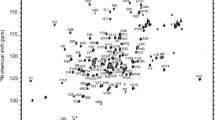Abstract
Single-stranded DNA-binding proteins (SSBs) are highly important in DNA metabolism and play an essential role in all major DNA repair pathways. SSBs are generally characterised by the presence of an oligonucleotide binding (OB) fold which is able to recognise single-stranded DNA (ssDNA) with high affinity. We discovered two news SSBs in humans (hSSB1 and hSSB2) that both contain a single OB domain followed by a divergent spacer region and a charged C-terminus. We have extensively characterised one of these, hSSB1 (NABP2/OBFC2B), in numerous important DNA processing events such as, in DNA double-stranded break repair and in the response to oxidative DNA damage. Although the structure of hSSB1 bound to ssDNA has recently been determined using X-ray crystallography, the detailed atomic level mechanism of the interaction of hSSB1 with ssDNA in solution has not been established. In this study we report the solution-state backbone chemical shift assignments of the OB domain of hSSB1. In addition, we have utilized NMR to map the DNA-binding interface of hSSB1, revealing major differences between recognition of ssDNA under physiological conditions and in the recently determined crystal structure. Our NMR data in combination with further biophysical and biochemical experiments will allow us to address these discrepancies and shed light onto the structural basis of DNA-binding by hSSB1 in solution.


Similar content being viewed by others
References
Ayed A, Mulder FA, Yi GS, Lu Y, Kay LE, Arrowsmith CH (2001) Latent and active p53 are identical in conformation. Nat Struct Biol 8:756–760
Bolderson E et al (2014) Human single-stranded DNA-binding protein 1 (hSSB1/NABP2) is required for the stability and repair of stalled replication forks. Nucleic Acids Res 42:6326–6336
Cai M, Huang Y, Sakaguchi K, Clore GM, Gronenborn AM, Craigie R (1998) An efficient and cost-effective isotope labeling protocol for proteins expressed in Escherichia coli. J Biomol NMR 11:97–102
Cubeddu L, White MF (2005) DNA damage detection by an archaeal single-stranded DNA-binding protein. J Mol Biol 353:507–516
Gamsjaeger R, Kariawasam R, Touma C, Kwan AH, White MF, Cubeddu L (2014) Backbone and side-chain (1)H, (1)(3)C and (1)(5)N resonance assignments of the OB domain of the single stranded DNA-binding protein from Sulfolobus solfataricus and chemical shift mapping of the DNA-binding interface. Biomol NMR Assign 8:243–246
Gamsjaeger R et al (2015) The structural basis of DNA-binding by the single-stranded DNA-binding protein from Sulfolobus solfataricus. Biochem J 465:337–346
Iftode C, Daniely Y, Borowiec JA (1999) Replication protein A (RPA): the eukaryotic SSB. Crit Rev Biochem Mol Biol 34:141–180
Pandita RK et al (2015) Single-strand DNA-binding protein SSB1 facilitates TERT recruitment to telomeres and maintains telomere G-overhangs. Cancer Res 75:858–869
Paquet N et al (2015) hSSB1 (NABP2/OBFC2B) is required for the repair of 8-oxo-guanine by the hOGG1-mediated base excision repair pathway. Nucleic Acids Res 43:8817–8829
Ren W, Chen H, Sun Q, Tang X, Lim SC, Huang J, Song H (2014) Structural basis of SOSS1 complex assembly and recognition of ssDNA. Cell Rep 6:982–991
Richard DJ et al (2008) Single-stranded DNA-binding protein hSSB1 is critical for genomic stability. Nature 453:677–681
Richard DJ, Bolderson E, Khanna KK (2009) Multiple human single-stranded DNA-binding proteins function in genome maintenance: structural, biochemical and functional analysis. Crit Rev Biochem Mol Biol 44:98–116
Acknowledgments
We would like to thank Dr Ann Kwan from the University of Sydney for expert advice and maintenance of NMR spectrometers. This work was supported by a NHMRC Project Grant (1066550) and by a Western Sydney University Women’s Research Fellowship to L.C.
Author information
Authors and Affiliations
Corresponding authors
Rights and permissions
About this article
Cite this article
Kariawasam, R., Touma, C., Cubeddu, L. et al. Backbone 1H, 13C and 15N resonance assignments of the OB domain of the single stranded DNA-binding protein hSSB1 (NABP2/OBFC2B) and chemical shift mapping of the DNA-binding interface. Biomol NMR Assign 10, 297–300 (2016). https://doi.org/10.1007/s12104-016-9687-6
Received:
Accepted:
Published:
Issue Date:
DOI: https://doi.org/10.1007/s12104-016-9687-6




